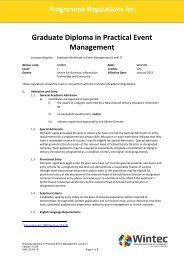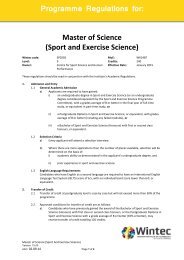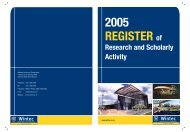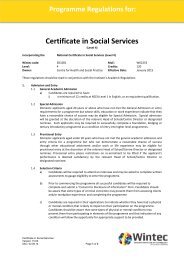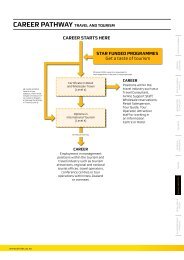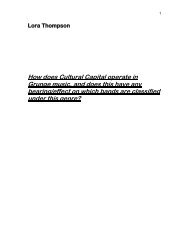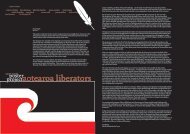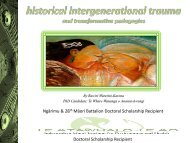Create successful ePaper yourself
Turn your PDF publications into a flip-book with our unique Google optimized e-Paper software.
WINTEC - A HISTORY OF THE LAND ON WHICH OUR CITY<br />
CAMPUS SITS<br />
The hill upon which Waikato Institute <strong>of</strong> Technology (<strong>Wintec</strong>) is currently sited is part <strong>of</strong> the<br />
traditional lands <strong>of</strong> the local hapū Ngāti Wairere, and it has considerable significance to that<br />
hapū.<br />
In pre-European times the geomorphology <strong>of</strong> the hill was considerably different from that seen<br />
today. It was extensively modified in the 1930's, during the early development <strong>of</strong> Hamilton<br />
City.<br />
The hill was originally part <strong>of</strong> a steep sided (1 in 14 gradient), long ridge or promontory that<br />
extended from what is now Ruakiwi Road down Hill street, Tristram Street, through to Garden<br />
Place and onwards to Victoria Street. A cutting was made through the ridge to allow the<br />
formation <strong>of</strong> Angelsea Street. Later the ridge on the river side <strong>of</strong> Angelsea Street was<br />
bulldozed away, thereby flattening the area for the development <strong>of</strong> what is now Garden Place<br />
and the central CBD around the Hamilton City Council buildings. The bulldozed earth was<br />
trucked away and used to fill various gullies, such as Waitawhiriwhiri gully to facilitate the<br />
formation <strong>of</strong> roads across these waterways.<br />
Pre-European <strong>History</strong> <strong>of</strong> the Area<br />
The promontory that was bulldozed away was known to pre-European Māori as Te Kōpū<br />
Mania O Kirikiriroa (the smooth belly <strong>of</strong> Kirikiriroa). The fertility <strong>of</strong> its soils was famous<br />
throughput the district and allowed the development <strong>of</strong> extensive cultivations <strong>of</strong> kūmara, and<br />
rauruhe (fern root), particularly on the northern slopes <strong>of</strong> the ridge. It dominated the<br />
landscape to the southern end <strong>of</strong> Kirikiriroa Pā between London Street and Bryce Street and<br />
was revered by Ngāti Wairere as a tribal landmark.<br />
The lower parts <strong>of</strong> the hill were generally swampy areas where taro were planted and<br />
cultivated. There were also numerous water springs (puna) along the lower slopes <strong>of</strong> the hill.<br />
A tūāhu (ceremonial altar) named Te Ahurewa stood on the peak <strong>of</strong> the ridge. This was<br />
established to maintain and protect the Mauri <strong>of</strong> the hill, its fertility and associated life<br />
sustaining properties. Tribal deities were believed to reside within the tūāhu. Ancient chants<br />
and rituals were performed at the tūāhu, calling upon the resident deities to bless the planting<br />
<strong>of</strong> the crop and ensure a bountiful harvest.<br />
The hill was also an observation point from which pre-European Māori watched for the skies<br />
for the appearance <strong>of</strong> certain stars and constellations which marked the timing for different<br />
phases <strong>of</strong> planting and harvesting <strong>of</strong> crops.<br />
Te Ao Katoa, a Ngāti Koura high priest <strong>of</strong> the cult <strong>of</strong> Io (the most sacred <strong>of</strong> ancient Māori<br />
religions) is believed to have performed one <strong>of</strong> the last ancient ritual on this hill, during his<br />
visit to Kirikiriroa, with King Tāwhiao, in July 1881. The ritual was performed to remove the<br />
tapu from the hill so that the Mauri <strong>of</strong> the hill would no longer be desecrated by Europeans<br />
walking on it, or by the housing that was being developed on the hill.
At various times, the ancestors <strong>of</strong> Ngāti Wairere who were buried at various localities on this<br />
hill were exhumed by Hakopa Te Waharoa (died 1877) and Te Puke Waharoa from the time<br />
<strong>of</strong> the arrival <strong>of</strong> the settlers in 1864.<br />
In pre-European times the hill was covered with rangiora and other native trees and ferns with<br />
isolated stands <strong>of</strong> kahikatea and tawa trees. The berries provided food for a whole variety <strong>of</strong><br />
native birds such as the kūkū (native pigeon) and the kōmako (bellbird), which were hunted<br />
and trapped in this vicinity. Periodically areas <strong>of</strong> this vegetation was cleared away and burnt<br />
to make an area for development <strong>of</strong> a garden for cultivation <strong>of</strong> crops. Most <strong>of</strong> the ancient<br />
Māori practices that were performed on this hill before Europeans came to the Waikato<br />
stopped around 1849 following the conversion <strong>of</strong> numbers <strong>of</strong> Ngāti Wairere to Christianity.<br />
Kirikiriroa Pā, positioned between what is now London and Bryce Streets, was the centre for<br />
the early Christian missionaries who undertook these conversions. Indeed, the first "church"<br />
in the Hamilton City area, named Tohikitierangi, was a thatched, raupō building constructed at<br />
Kirikiriroa Pā. This was used for Christian services by visiting missionaries. The work <strong>of</strong> these<br />
missionaries is demonstrated in a record from January 1849, when approximately 40 adult<br />
Ngāti Wairere were baptised on the canoe-landing site, on the bank <strong>of</strong> the Waikato River,<br />
below the Pā. This canoe-landing site can still be seen today.<br />
Post arrival <strong>of</strong> Europeans.<br />
The arrival <strong>of</strong> Europeans in the Waikato saw a major change in the crops that were grown on<br />
the hill. Maize, potato, tobacco, peach trees, apple trees, cabbages, corn, and pumpkin<br />
replaced the traditional kūmara and fern crops. These were not traditional or staple diets for<br />
Māori and were mostly grown to supply the ever-growing number <strong>of</strong> European settlers in the<br />
Auckland area.<br />
It is believed that European concepts <strong>of</strong> farming and horticultural production were introduced<br />
to this area by Korehako, a European who was captured at Aotea harbour, near Kawhia by an<br />
Ngāti Koura war party. He was transported inland to Te Rapa Pā (by the Waikato Hospital)<br />
and later lived amongst Ngāti Wairere at Kirikiriroa Pā. Early European missionaries recorded<br />
seeing him in this location during the early 1840's, but noted his poor state <strong>of</strong> mental health.<br />
Structures and associated features on the hill.<br />
There were a variety <strong>of</strong> wooden structures associated with religious ceremonies, or food<br />
preparation stood on the hill in pre-European times, the remnants <strong>of</strong> some <strong>of</strong> these features,<br />
along with artefacts and kōiwi associated with their use and the occupation <strong>of</strong> the hill may well<br />
still be buried on the <strong>Wintec</strong> site while others may have long perished.<br />
THESE STRUCTURES INCLUDED:<br />
• WHATA - (Drying Platform). These were essentially raised flat platforms. Kūmara and<br />
gourds were laid out on them to dry in the sun, thereby preserving then for future use.<br />
What were still in use in Aotea and Hukanui up to the mid 1930's.<br />
• WHARE PORA - (Manufacturing houses). Whare pora were houses specifically<br />
constructed for the preparation <strong>of</strong> flax (muka) and the manufacture <strong>of</strong> textiles and<br />
garments from flax fibres. In the whare pora women, and sometimes men, scraped<br />
the flesh from the leaves to extract the strong fibres. These were then woven in the<br />
whare pora into korowai (cloaks), other garments, kete (baskets), lashings, cords and<br />
ropes. Manufacturing flax into lashings, cords and particularly ropes for sailing ships<br />
provided Māori with an important economic base once Europeans arrived in the area.<br />
• KĀUTA - (Shed for storing firewood and hāngī stones). Kāuta were open sided, wood<br />
framed sheds with thatched raupō ro<strong>of</strong>s. They were used for storing firewood and<br />
hāngī stones to keep dry. Often, in bad weather, the hāngī would be constructed and<br />
the food cooked under the kāuta.
• WHATARANGI - (A platform for <strong>of</strong>ferings). Food was placed on whatarangi as<br />
<strong>of</strong>ferings to Māori deities to seek their help in warding <strong>of</strong>f mākutu (curses or<br />
witchcraft) placed on the area or location by other tribes or opponents. At other times<br />
<strong>of</strong>ferings were made in whatarangi during traditional planting and harvest ceremonies<br />
to ensure the bounty <strong>of</strong> the crop.<br />
• PĀTAKA - (Elaborately carved, elevated storehouse). Pātaka were especially sacred<br />
and venerated by pre-European Māori, because they commonly contained taonga<br />
(precious and sacred artefacts) which were highly valued by the chief, as well as<br />
food.<br />
• POU HĀKARI - (Platform). A pou hākari was a triangular platform, covered with a<br />
thatched ro<strong>of</strong>, raised up on three poles. They were used for storing or displaying food<br />
and were commonly erected within gardens and cultivations as part <strong>of</strong> a hākari<br />
(feast).<br />
• TŪĀHU - (Ceremonial shrine). Ngāti Wairere deities were believed to reside in tūāhu.<br />
They had a variety <strong>of</strong> shapes and construction depending on the origin <strong>of</strong> the deity<br />
that they commemorated. One form <strong>of</strong> tūāhu derived from the Ngāti Wairere practice<br />
<strong>of</strong> giving a chief who was slain in battle the status <strong>of</strong> a deity. These chiefly deities<br />
were commemorated by construction <strong>of</strong> a tūāhu which was a fenced <strong>of</strong>f area in which<br />
the preserved tattooed head <strong>of</strong> the chiefs were displayed, mounted on sticks. Other<br />
tūāhu were simply earthen mounds with talisman stones placed on their surface.<br />
Tūāhu were usually fenced around their perimeter to keep dogs out. The fences also<br />
protected the tūāhu from damage by pigs, once they were introduced by European<br />
settlers.<br />
• WHĀNGAI-HAU - (Ceremonial Ovens). Pre-European Māori constructed umu (in<br />
ground ovens) for cooking food. The whāngai-hau was a special ceremonial oven,<br />
used only for cooking the bodies <strong>of</strong> slain enemy warriors prior to consuming their<br />
flesh.<br />
• MAURI - (Stone objects) which were sometimes planted within special gardens, used<br />
as talisman for sacred rituals associated with gardening.<br />
• TAUMATA ATUA - (A carved figure) which houses a sacred spirit, which protects the<br />
area.<br />
• UMU - Ovens used for the cooking <strong>of</strong> various food items for domestic purposes.<br />
• PUKE-AHU - Small sacred mounds that were used for the planting <strong>of</strong> kūmara tubers<br />
and other crops, usually grown in rows.<br />
• KIRIKIRI - Gravel soils prepared for gardens. Commonly termed "modified soils" by<br />
archaeologists.<br />
• UKU - Clay.<br />
• TAUPA - An ancient pre-European term used locally for describing cultivations, which<br />
is now, obsolete.<br />
• TAPAAHI - Hollowed depressions where soils were excavated for the formation <strong>of</strong><br />
garden soils.
• RUA-KŪMARA - Underground storage pits for kūmara and other food crops.<br />
• MARERE - A sacred umu (oven) associated with the planting ceremonies for the<br />
kūmara.<br />
OTHER ITEMS MAY INCLUDE:<br />
Shattered hāngī stones, agricultural implements, fresh water mussel shells and associated<br />
middens, obsidian flakes, stone tool implements and introduced European items used from<br />
the time <strong>of</strong> European contact such as clay pipes etc.<br />
Hapū who were associated with the area or cultivated the hill.<br />
The hill and surrounding area that was renowned for its cultivation and produce was<br />
developed by Ngāti Wairere and its hapū (sub tribes). They are:<br />
1 NGĀTI WAIRERE<br />
The renowned warrior Māhanga was a descendant in direct line from Hoturoa, the captain <strong>of</strong><br />
the Tainui canoe. Māhanga lived at Purakau Pā, located at the confluence <strong>of</strong> the Waipa River<br />
and Kaniwhaniwha stream, south <strong>of</strong> what is now Whatawhata. He had two daughters,<br />
Waitawake and Tukotuku.<br />
Kokako was a chief whose origins linked back to another canoe, the Mātaatua canoe. It is<br />
believed that he was responsible for the drowning <strong>of</strong> Tūheitia, Māhanga's father. As a result<br />
Māhanga and Kokako were continually in dispute and were warring adversaries. Kokako had<br />
several children, the most famous being a son named Tamainupo.<br />
Māhanga's daughter Tukotuku married Kokako's son Tamainupō, and they settled at Te<br />
Kaurere, a papa kāinga along the banks <strong>of</strong> the Waitetuna River that runs near the Raglan<br />
deviation.<br />
Tamainupō and Tukotuku had only one son, Wairere. The birth <strong>of</strong> the son was so significant<br />
that after Kokako baptised Wairere in the Waikato River, he made peace with Māhanga at<br />
Purakau Pā. To mark Wairere's birth the ancient name <strong>of</strong> the river was changed from Te<br />
Awanui O Taikehu to Waikato - Waikato meaning "to pluck water" and refers to the motion <strong>of</strong><br />
sprinkling water on the child during the Tohi (baptism ritual). Wairere's baptism ritual was<br />
performed at Taipouri Island near Huntly. In later life Wairere had several wives who<br />
produced many sons, daughters and numerous descendents. In his old age, Wairere travelled<br />
southwards to the Taupō district and married Hikataupo a Chieftainess <strong>of</strong> the Ngāti<br />
Tūwharetoa and died there. From Wairere and Hikataupo, descend the dynasty <strong>of</strong> Te<br />
Heuheu, the paramount chiefs <strong>of</strong> the Ngāti Tūwharetoa <strong>of</strong> the Lake Taupō Districts.<br />
2 NGĀTI KOURA<br />
Paoa, a Tainui chief, lived at Kaitotehe Pā opposite Taupiri mountain with his first wife<br />
Tauhakari. They had three children: two sons Toapoto, Toawhane and one daughter, Koura<br />
after whom this hapū was named. Through the intermarrying <strong>of</strong> Koura's descendants with<br />
people from Ngāti Wairere, Ngāti Koura became closely aligned with Ngāti Wairere.<br />
Following Koura's birth, Paoa's brother Mahuta visited him at Kaitotehe Pā. As this was a time<br />
when food was scarce the people <strong>of</strong> the Pā could not <strong>of</strong>fer Mahuta a proper feast. Taking this<br />
as an insult to his brother, Paoa left Kaitotehe Pā, abandoning his first family, and moved to<br />
the Hauraki district. There he took a second wife named Tukutuku and with her had two sons,<br />
Tipa and Horowhenua.<br />
In his old age, Paoa returned to the Waikato and searched for his first family, eventually<br />
finding them at Te Hoe O Tainui. However, the second family resented Paoa's actions and as<br />
a consequence there was a battle outside the Pā in which Tipa and Horowhenua killed<br />
Toawhana and Toapoto, Koura's two older brothers.
Tipa and Horowhenua then challenged any one inside the Pā who was bold enough to come<br />
out and fight them. Koura, armed with a Taiaha named Hua Katoa, came out to answer the<br />
challenge. Because it was a woman who answered their challenge Tipa and Horowhenua<br />
realised that they had killed all <strong>of</strong> the senior male line <strong>of</strong> Koura's family, but did not realise that<br />
Koura was indeed their half sister. As there was no more male line and they would not fight a<br />
woman, Tipa and Horowhenua declared peace between the two families.<br />
Koura buried the sacred Taiaha, named Huakatoa, on the peak <strong>of</strong> Mount Hangawera. At the<br />
same time she declared that all the lands from Mt Hangawera to the West should be invaded<br />
and taken from the Ngā Iwi who lived there. This was achieved by her grandson Hotumauea,<br />
the renowned warlord, who thereby established the traditional lands <strong>of</strong> Ngāti Koura.<br />
Koura had several husbands, one <strong>of</strong> whom was Waenganui, a famous war Chief whose<br />
descendants, Ngāti Waenganui, live at Parawera. When Koura died her bones were<br />
deposited in a burial cave named Katokato near Taupiri. The location <strong>of</strong> this cave is still<br />
known to her descendants.<br />
3 NGĀTI HANUI<br />
Hanui was the third child <strong>of</strong> Maramatutahi and Paretahuri. Maramatutahi was the son <strong>of</strong><br />
Wairere's third wife Tukapua. Paretahuri was the eldest child <strong>of</strong> Hekemaru and Hekeiterangi<br />
and the elder sister <strong>of</strong> Mahuta and Paoa.<br />
Hanui became one <strong>of</strong> Ngāti Wairere's greatest hand-to-hand combat warriors. It was Hanui<br />
and Hotumauea who conquered the Ngā Iwi people <strong>of</strong> this region and claimed large areas <strong>of</strong><br />
their lands for Ngāti Wairere and their sub-tribes. On his death Hanui was buried at Karamu<br />
Pā in Gordonton. In the late 1880's his bones, and those <strong>of</strong> Hotumauea, were exhumed under<br />
the supervision <strong>of</strong> King Tawhiao and Te Puke Waharoa, to protect them from possible<br />
degradation during the land wars. They were reburied at Taupiri mountain. The location <strong>of</strong><br />
these burial sites is still known to a few <strong>of</strong> their living descendants.<br />
4 NGĀTI NGAMURIKAITAUA<br />
This hapū derives its name from an event that occurred sometime during the 1600's.<br />
Following an unidentified battle, a number <strong>of</strong> dead warriors' bodies were placed in a canoe<br />
moored on the Waikato river to await their burial. However the canoe broke it's mooring and<br />
floated down stream, where it was seized by a group <strong>of</strong> Māori as it floated by. They cooked<br />
the decomposing bodies in a specially constructed Umu (oven) and ate them. From then<br />
onwards this group were known as Ngamurikaitaua, the name describing the eating <strong>of</strong> these<br />
decomposing bodies.<br />
Ngāti Ngamurikaitaua warriors took part in the famous Hingakaka battle, fought near Ohaupo<br />
close to the shores <strong>of</strong> Lake Ngaroto. This was one <strong>of</strong> the largest pre-European battles.<br />
Detailed descriptions <strong>of</strong> this battle are given in Dr Pei Te Hurinui Jone's book "Potatau" and<br />
Pr<strong>of</strong>essor Bruce Biggs' book "Nga Iwi O Tainui".<br />
Apart from being fierce warriors, Ngāti Ngamurikaitaua was renowned for making a particular<br />
type <strong>of</strong> rain cape called Pureki, woven from very rough flax fibres. The hapū was also<br />
renowned for the special rites and rituals that they performed prior to going into battle.<br />
5 NGĀTI PAREKIRANGI<br />
Parekirangi was a direct female descendent <strong>of</strong> Wairere. Ngāti Parekirangi is a small hapū<br />
whose traditional lands are now part <strong>of</strong> Hamilton East.<br />
Pirihi Tomonui was one <strong>of</strong> Parekirangi's more recent descendants <strong>of</strong> note. He was a<br />
significant member <strong>of</strong> King Potatau Te Wherowhero's Rūnanga (parliament) and fought<br />
against the British troops at the battle <strong>of</strong> Rangiriri in 1863. Pirihi Tomonui died at Tauhei in<br />
1891. He was responsible for the dismantling <strong>of</strong> the large meetinghouse, named Wairere,<br />
which stood at Te Rapa Pā, now Cobham Drive, near the Waikato Hospital. Another famous<br />
chief <strong>of</strong> this hapū was Iraia Papoto, a fully tattooed war chief who fought against Te
Rauparaha in 1816. Iraia Papoto in his old age died from injuries sustained after falling from<br />
his horse in 1879. He is buried at Tauhei. It is believed that he had no direct issue.<br />
6 NGĀTI IRANUI<br />
Iranui was the second son <strong>of</strong> Wairere from his first wife Hinemoa. He was famous as a<br />
cultivator <strong>of</strong> Kūmara on his land at Taupiri. Because <strong>of</strong> this fame, Ngāti Mahuta attacked and<br />
drove him away so that they could occupy and cultivate his fertile land. He later occupied<br />
Mangaharakeke Pā, located behind the Anchor Dairy factory site at Te Rapa and "farmed" a<br />
number <strong>of</strong> cultivations within what are now the Hamilton City boundaries.<br />
Iranui was not only a renowned farmer but was also a warrior <strong>of</strong> note. He led a war party to<br />
attack a famous warrior - Rangipotiki - at Aotea Harbour on the west coast. Iranui killed<br />
Rangipotiki and hung his body up on a Karaka tree for a time, before cutting it up and<br />
distributing parts to various people in the war party.<br />
In retaliation, Rangipotiki's hapū from Aotea Harbour raised a war party that came to<br />
Mangaharakeke Pā where Iranui lived. At that time they did not know the specific identity <strong>of</strong><br />
the people who had killed Rangipotiki. As part <strong>of</strong> the traditional greeting ceremony at the Pā,<br />
Iranui served them cooked human flesh, including parts <strong>of</strong> Rangipotiki. The leaders <strong>of</strong> the war<br />
party recognised some <strong>of</strong> Rangipotiki's tattoos on the flesh that they had been given to eat<br />
and hence realised that Iranui, their host, had killed Rangipotiki.<br />
Iranui managed to escape from the Pā, pursued by the war party from Aotea Harbour, and<br />
swam across the Waikato river. As he travelled along one <strong>of</strong> the walking tracks to Te<br />
Papanui, which is now the Five Cross-roads area, he was caught by the Aotea war party and<br />
killed. In retaliation for having killed Rangipotiki, they degraded his body and mana by<br />
hanging him upside down from the post <strong>of</strong> a Pataka (carved food house).<br />
7 NGĀTI WAIKAI<br />
Waikai was the youngest daughter <strong>of</strong> Maramatutahi, but at present little is now known about<br />
her. Her brother was Hanui, the famous warrior described above. From the vast lands that he<br />
conquered, Hanui set aside pockets <strong>of</strong> land for Waikai to settle. This included the present day<br />
Puketaha and Chartwell areas.<br />
8 NGĀTI TE AO<br />
Little is known about the origins <strong>of</strong> this hapū. They occupied Whatanoa Pā, located close to<br />
the Waikato Stadium and Waitawhiriwhiri Pā above the Fairfield Bridge. They were attacked<br />
by Hanui and Hotumauea who killed their main chief, Taiko. The preserved, tattooed head <strong>of</strong><br />
Taiko, along with the heads <strong>of</strong> Mohihotuhotu and another unidentified Ngāti Wairere chief<br />
were uncovered when an excavator broke into a burial cave in the bank <strong>of</strong> the Waikato river<br />
during the construction <strong>of</strong> the foundations for the Fairfield Bridge.<br />
9 NGĀTI PARETAUA<br />
Is a sub-tribe <strong>of</strong> Ngāti Wairere: Paretaua was one <strong>of</strong> the wives <strong>of</strong> Hanui. Little is known about<br />
her except that a hapū bearing her name lived at Opoia Pā, near the Claudelands Bridge. It is<br />
believed that she was buried at Karamu Pā at Hukanui alongside Hanui, her husband.<br />
10 NGĀTI HAUMI<br />
Currently little is known about the origins <strong>of</strong> this hapū. However it came under the leadership<br />
<strong>of</strong> Hakopa Te Waharoa, a senior chieftain <strong>of</strong> the Ngāti Wairere in 1850. It is believed that the<br />
name <strong>of</strong> Ngāti Haumi derives from an upended prow <strong>of</strong> a canoe, which was used for storing<br />
human remains. After the 1863-1864 Waikato <strong>Land</strong> Wars, Hakopa Te Waharoa settled on his<br />
ancestral lands at Hukanui (Gordonton) in 1864. Hakopa Te Waharoa uplifted ancestral<br />
remains from burial grounds and caves within Hamilton from 1865. He died in 1877.<br />
Wiremu Puke<br />
Ethnographic Researcher<br />
Nga Mana Toopu O Kirikiriroa



